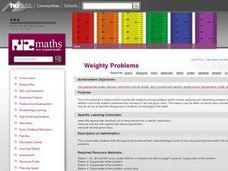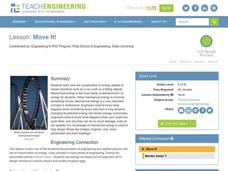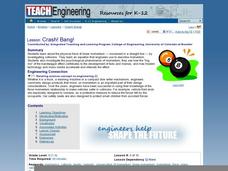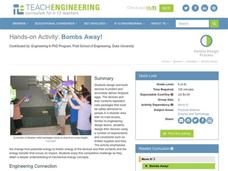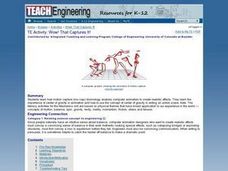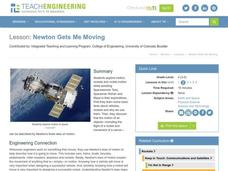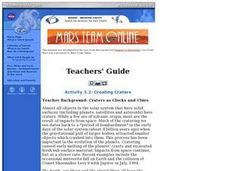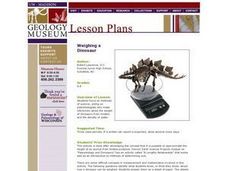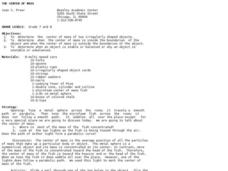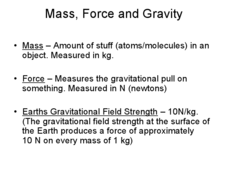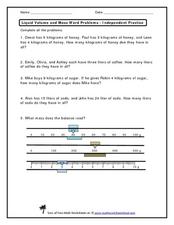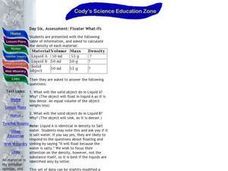Curated OER
What State Are You?
Students identify three states of matter and recognize plasma as fourth state. They provide examples of matter that are classified in particular state and identify properties of each state of matter.
Curated OER
Mass: Applying and Interpreting
Young scholars rotate through six studying stations solving problems that involve applying and interpreting aspects of mass. They solve various word problems, and measure the contents of cans and calculate the mass of two cans.
Curated OER
Move It!
Students observe a demonstration presented by the teacher covering different types of energy. They participate in an experiment where they study numerous physics vocabulary words and visit websites that demonstrate examples of these...
Curated OER
Forces and Graphing
Students analyze graphs to determine relationships between variables and rates of change. They determine the basic concepts about static reaction forces. They determine the slope and equation of a line.
Curated OER
Crash! Bang!
Students study the physical force of linear momentum by investigating collisions. They analyze the difference between elastic and inelastic collisions. They calculate linear momentum.
Curated OER
Bombs Away!
Students design and build a device to protect and accurately deliver a dropped egg. They review and study a number of vocabulary words that are associated with this lesson. They work in a small group in order to develop a successful...
Curated OER
TE Activity: Wow! That Captures It!
Students examine how motion capture technology allows computer based animators to design realistic effects in animation. They study how the center of gravity contributes to animation and how to use the center of gravity to write an...
Curated OER
Terror in Space
Students view a video clip about the role of satellites in space. They examine the concept of center of mass. They participate in an experiment showing how altering the location of an object's center of mass can change its motion.
Curated OER
Newton Gets Me Moving
Students discuss Newton's laws of motion. The conduct motion experiments by building "Newton Rocket Cars" from assorted materials. They propel the cars with rubber bands and wooden blocks and record the distance traveled on data sheets.
Curated OER
What Floats Your Boat?
Students are introduced to the concept of buoyancy. The Video used in this instructional activity demonstrates and explains the characteristics of objects that sink and float. It presents the concepts of displacement, weight, and buoyancy.
Curated OER
Density Derby
Students explore the relationship between mass, volume and density. They use model boats to discover how changing mass and volume affect density. This is a very engaging lesson plan which provides great demonstrations and hands-on...
Curated OER
Density And Volume
Sixth graders explore the concept of density as a relationship of an object's mass to its volume. Densities of a variety of objects are compared and used to identify an unknown object.
Curated OER
Creating Craters
Students explore parts of an impact crater and compare and contrast craters found in Earth, the Moon, and Mars. Crater formation is modelled and the relationship of mass, velocity, and size of the projectile to the crater formation is...
Curated OER
Weighing a Dinosaur
Learners role play as paleontologists who make inferences about the weight of dinosaurs. They use models and the density of water to make these inferences.
Curated OER
What's the Matter? (Grades 6-7)
Students explain the physical properties of matter. They, in groups, perform a variety of experiments, each demonstrating a different property of matter. A very nice, hands-on lesson!
Curated OER
MASS
Students distinguish between weight and mass. They examine how in oscillations of a mass against an elastic spring--in the absence of gravity, or in horizontal motion--the length of the oscillation period is proportional to the square...
Curated OER
The Center of Mass
Students determine the center of mass of two irregularly shaped objects, determine when the center of mass is inside or outside the boundaries of the object, determine when and/or why an object is stable, balanced, unstable or unbalanced.
Curated OER
Newton's Laws
Beginning with definitions of mass and foce, this excellent set of slides summarizes Newton's Laws of motion and universal bravitaions. Components of each law are explained along with examples and questions to inspire discussion. This is...
Curated OER
Mass, Force, and Gravity
Definitions of gravity and weight and the calculations involved with their manipulation are covered here. The equations and resource links will be valuable to show a physics class. Use it as a note-taking support for your lecture on...
Curated OER
Liquid Volume and Mass Word Problems
As your scholars become comfortable with liquid mass and volume units, give them these addition and subtraction word problems to help apply the skill. There are no conversion or fraction skills involved. After solving four word problems,...
Curated OER
What in the World is Matter?
How does matter change and what are its properties? This presentation is a bit scattered and attempts to infuse humor in place of concrete definitions. In order to make this worthwhile for classroom use, you will need to add to it.
Curated OER
Density
In this biology learning exercise, learners use the given clues at the bottom of the sheet to solve the crossword puzzle on density. They identify how density in mass is divided. Students also measure the density of water in grams.
Curated OER
Day Six: Floater What Ifs
Learners observe earth science by examining results from an experiment. In this buoyancy lesson, students practice floating different items in two different liquids and identify why certain objects will float and others sink. Learners...
Curated OER
Center of Mass, Tangent Line Error Bound
In this center of mass worksheet, students determine the center of mass of an isosceles triangle. They examine functions and determine the tangent error bound. This one-page worksheet contains 5 problems.

